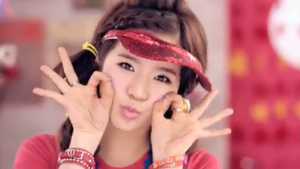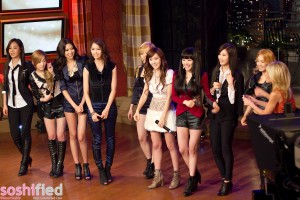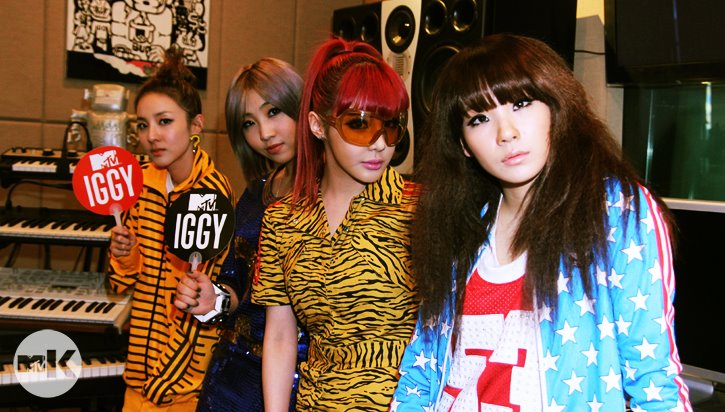 My co-writer Gil recently wrote about the problem of misleading and narrow journalism regarding K-pop in non-Korean/Western media outlets, and she isn’t wrong. Western media outlets have definitely figured out by now that K-pop is a thing, and they are certainly aware that it has earned a good deal of attention in Asia; however, as Nabeela pointed out, they seem to have no idea how to represent it in a realistic way. Nor do many of the journalists writing about K-pop seem to do their research — articles attempting to explain Hallyu make outrageous generalizations or make claims based on faulty information or speculation. One article recently published in the Wall Street Journal — which is ordinarily a highly reputable publication — claimed that SNSD boasted three English speakers, citing that Tiffany, Jessica, and Sunny were all born in the US. The latter is true; the former is obviously not. Such misrepresentation paints a bizarre picture of K-pop that is ironically most unfamiliar to those who are most familiar with K-pop: K-pop fans.
My co-writer Gil recently wrote about the problem of misleading and narrow journalism regarding K-pop in non-Korean/Western media outlets, and she isn’t wrong. Western media outlets have definitely figured out by now that K-pop is a thing, and they are certainly aware that it has earned a good deal of attention in Asia; however, as Nabeela pointed out, they seem to have no idea how to represent it in a realistic way. Nor do many of the journalists writing about K-pop seem to do their research — articles attempting to explain Hallyu make outrageous generalizations or make claims based on faulty information or speculation. One article recently published in the Wall Street Journal — which is ordinarily a highly reputable publication — claimed that SNSD boasted three English speakers, citing that Tiffany, Jessica, and Sunny were all born in the US. The latter is true; the former is obviously not. Such misrepresentation paints a bizarre picture of K-pop that is ironically most unfamiliar to those who are most familiar with K-pop: K-pop fans.
But that aside, occasionally Western coverage of K-pop reaches new heights of inanity, where the reporting involved could hardly even be deemed as “journalism.” Such is the latest piece out of Rolling Stone, a popular music magazine, which purports to identify the top 10 K-pop acts most likely to make it in the US. This article (if one could even call it that) is so rife with misinformation and straight-up non-facts that I don’t even know where to begin with it. More to the point, however, is that the article was very obviously written by an individual with little or no familiarity with K-pop whatsoever — and this makes it very, very difficult to take anything he says seriously.
 The article’s first problem is the top 10 list itself. In order of appearance, the author identifies 2NE1, SNSD, Big Bang, Wonder Girls, After School, B2ST, Ailee, SISTAR, SHINee, and miss A. Now, there is no doubt that some of these groups are indeed prime contenders; having artists who have already exhibited some degree of participation in the American market like SNSD, 2NE1, and Wonder Girls (however successful or unsuccessful it may have been), they at least make sense. However, there are some real head-scratchers on this list. B2St? After School? SISTAR? When have any of those groups ever made any legitimate K-pop fan’s list of acts with the most crossover potential? When have any of those groups ever expressed any sort of desire to break into the US market?
The article’s first problem is the top 10 list itself. In order of appearance, the author identifies 2NE1, SNSD, Big Bang, Wonder Girls, After School, B2ST, Ailee, SISTAR, SHINee, and miss A. Now, there is no doubt that some of these groups are indeed prime contenders; having artists who have already exhibited some degree of participation in the American market like SNSD, 2NE1, and Wonder Girls (however successful or unsuccessful it may have been), they at least make sense. However, there are some real head-scratchers on this list. B2St? After School? SISTAR? When have any of those groups ever made any legitimate K-pop fan’s list of acts with the most crossover potential? When have any of those groups ever expressed any sort of desire to break into the US market?
But the list itself isn’t really the problem here. What is wholly problematic is that the author of this article simply cobbled together a list of somewhat popular and relevant K-pop acts whose Wikipedia pages likely indicate that they’ve won some sort of (potentially) meaningless award or recognition while using English skills (exaggerated or not) as some kind of index for success.
Let’s get started.
The article’s introduction makes two key points about K-pop in the US: (1) that acts like BoA and Se7en failed because they were “molded by American record labels to be presented in a way they saw best to break into the notoriously difficult market,” and (2) that K-pop has done well enough for itself without having had any major American backing. Yet by the time the author gets around to covering the list, he uses the participation of American songwriters and producers in K-pop as a major indicator of success potential in the US. He cites 2NE1’s collaborations with will.i.am and Jeremy Scott, as well as SNSD’s work with Teddy Riley, Big Bang’s work with Diplo and Pixie Lott, and Wonder Girls’ use of popular American songwriters. What he fails to mention is that some (actually, most) of these collaborations are devoid of any real significance. I mean, Pixie Lott is barely even relevant in her home country, and despite having worked with some huge names (including the late Michael Jackson), Teddy Riley is teetering on the edge of relevance in the US. But more notable is his omission of the fact that pretty much none of these collaborations have paid off in any meaningful way. Did touring with The Jonas Brothers skyrocket the Wonder Girls to fame and fortune in the US? Hardly. Did SNSD’s The Boys sell big? Nope. Nobody wants to admit it, but they’re doing just about as well as BoA ever did in the US — and I still contend that she flopped largely because one of her songs was called “Girls on Top.” But I digress.
 Moving on, a majority of artists on the list is noted as having won some nebulous award or honor that in theory recognizes their ability and success. However, as has been discussed many a time, one simply cannot define success in K-pop by numbers alone. Many, many K-pop fans have by now come to realize that numbers mean almost nothing. Numbers have garnered bajillions of trophies on music programs and at music awards shows without actually speaking to the ability of any of the performers or even the quality of their music. Did 2NE1 deserve to win MTV Iggy‘s award for Best New Band in the World? Maybe, but even if they truly didn’t, K-pop’s hordes and hordes of screaming fans, which are inspired by an insanely bred fan culture, would have ensured that some K-pop act had walked home with the award anyway. Did SISTAR really deserve the inaugural spot on Korea’s Billboard Chart? The “honor” really could have gone to anyone who happened to be making a timely comeback — and no, it really doesn’t matter at all that most of SISTAR’s hits were produced by Brave Brothers; if anything, that has only hindered their success. Does anyone in K-pop find any meaning in the fact that After School was the first winner of Billboard Japan for K-pop? Does anyone even care? And does any of this have any bearing on how successful any of these groups will be outside of Asia?
Moving on, a majority of artists on the list is noted as having won some nebulous award or honor that in theory recognizes their ability and success. However, as has been discussed many a time, one simply cannot define success in K-pop by numbers alone. Many, many K-pop fans have by now come to realize that numbers mean almost nothing. Numbers have garnered bajillions of trophies on music programs and at music awards shows without actually speaking to the ability of any of the performers or even the quality of their music. Did 2NE1 deserve to win MTV Iggy‘s award for Best New Band in the World? Maybe, but even if they truly didn’t, K-pop’s hordes and hordes of screaming fans, which are inspired by an insanely bred fan culture, would have ensured that some K-pop act had walked home with the award anyway. Did SISTAR really deserve the inaugural spot on Korea’s Billboard Chart? The “honor” really could have gone to anyone who happened to be making a timely comeback — and no, it really doesn’t matter at all that most of SISTAR’s hits were produced by Brave Brothers; if anything, that has only hindered their success. Does anyone in K-pop find any meaning in the fact that After School was the first winner of Billboard Japan for K-pop? Does anyone even care? And does any of this have any bearing on how successful any of these groups will be outside of Asia?
Finally, the author selectively includes mentions of English prowess in his descriptions of some of the groups — but hilariously, nearly all of these mentions are complete and utter jokes. Despite being one of the only groups on the list that possesses bonafide English speakers, SNSD’s description is devoid of any mention of English ability, while the author writes that members of B2st, SHINee, and SISTAR have somehow proven their ability to communicate in English. To which the collective K-pop community says: LOL WHAT. Yes, yes, of course B2ST has members that are fluent in English! Check it out!
Also, SISTAR speaks English? Well, it is true that Dasom did interact with the audience at a show in Las Vegas — for about half a minute. Really, Rolling Stone? You’re going to make a statement about Dasom’s ability to promote her group in the United States based on one 53-second video clip, about half of which is completely unintelligible? This is some of the shoddiest and least credible reporting I have ever seen in my entire life.
Almost as problematic as what it is in the article is what has been left out. In constructing a list of acts that could potentially crossover to the US, the author ignores some of the very real problems that K-pop faces — including discrimination — in attempting to break into a new and unfamiliar market. Despite the fact that the article is about Korean pop, the author barely acknowledges that the artists themselves are all Korean — and that this could seriously hinder their opportunities for potential success in the US market. I think that many people (including  those in the K-pop industry) recognize that the simple fact that K-pop groups are Asian will impact how they are perceived by an unforgiving American or Western audience. Remember the twitter comments after SNSD performed on The Late Show with David Letterman? Or the Kids React to K-pop video? Americans and non-Asians are going to react to K-pop on the basis of its Asian-ness, and there’s just no getting around that. That the entire article could go on and on about Billboard wins and fake English skills without once mentioning the difficulty that Asian artists have gaining recognition in the West really speaks to the amount of research that was put into the piece. Which would be about none.
those in the K-pop industry) recognize that the simple fact that K-pop groups are Asian will impact how they are perceived by an unforgiving American or Western audience. Remember the twitter comments after SNSD performed on The Late Show with David Letterman? Or the Kids React to K-pop video? Americans and non-Asians are going to react to K-pop on the basis of its Asian-ness, and there’s just no getting around that. That the entire article could go on and on about Billboard wins and fake English skills without once mentioning the difficulty that Asian artists have gaining recognition in the West really speaks to the amount of research that was put into the piece. Which would be about none.
Finally (and here is where I start to sound like a broken record), what is really missing here is an emphasis on music, talent, and ability. Occasionally, the author makes an allusion to K-pop songs that seem to jive with American or Western sounds (as in miss A’s “Love Alone”), but most of his commentary really doesn’t speak to the fact that K-pop will simply go nowhere if the artists are untalented and/or can’t pull off convincing live performances. Awards, English, and big-name collaborations all mean nothing if the music can’t or doesn’t sell. And quite frankly, it isn’t selling. We’ve beaten the “who is going to make it in the US” horse so far into the ground that it recently resurfaced in China, but it bears repeating that currently, nobody really stands a chance of achieving real success in the US or Western market — which indicates that K-pop is still going about its Western ventures the wrong way. I certainly couldn’t tell you how to fix it, but I think it’s clear that K-pop faces more of an uphill battle than the Rolling Stone would have its readers believe. Bringing K-pop to the West is a hugely multifaceted and incredibly complicated issue that cannot easily be boiled down into a few buzzwords.
Overall, this Rolling Stone article was one of the worst Western reads on K-pop that I’ve seen in awhile — and that is saying something. The total misrepresentation of facts, total lack thereof of facts, and misinterpretation of available information speaks to a lack of journalistic integrity on behalf of this publication. If Rolling Stone or any other Western media outlet wishes to cover K-pop in the future, they’d do well to hire a writer who actually knows what he or she is talking about.
What do you think, Seoulmates? Did you find Rolling Stone‘s Top 10 list realistic? Who would make your Top 10?


